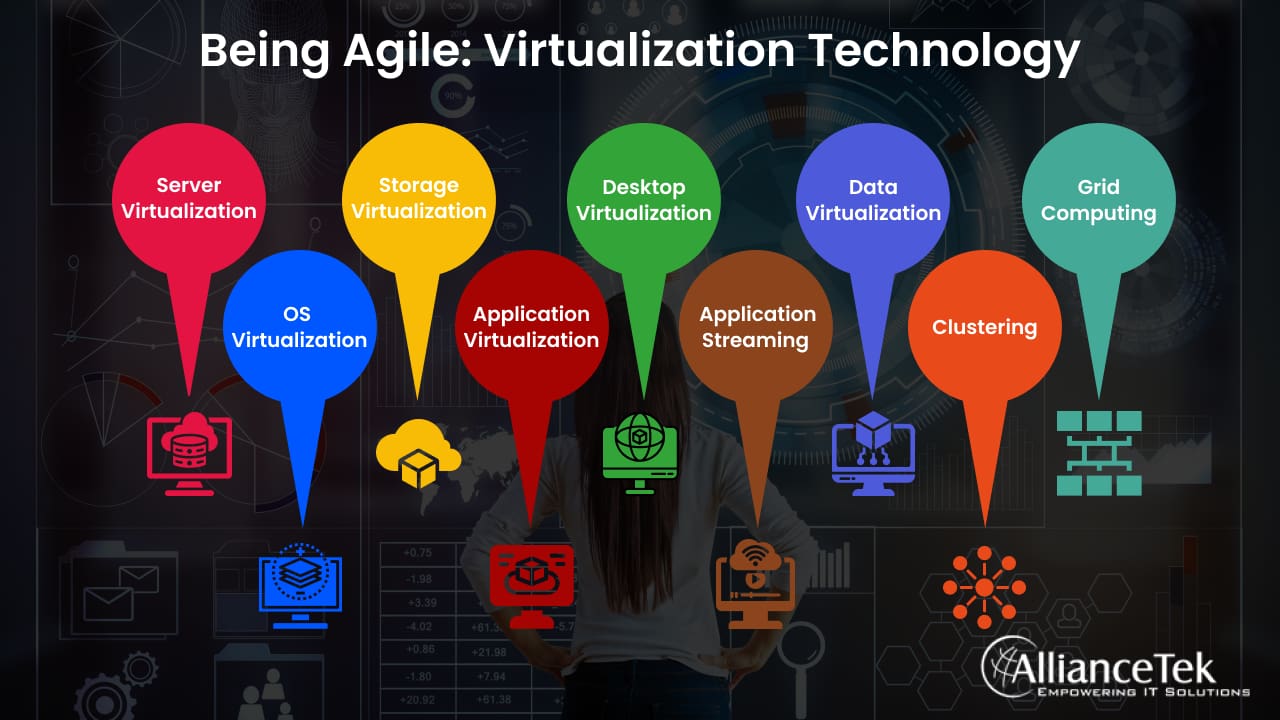Virtualization is the procedure to manage resources and systems by creating a virtual version of systems and resources. These comprise an operating system, server, storage devices, network resources and web applications. The Virtualization process enables these resources to appear and function as multiple logical (Virtual) resources, also this technology allows multiple physical resources to appear and function as a single logical resource.
Statistics show that 66% of companies have reported increased agility due to virtualization adoption. This can be linked to the improved operational efficiency observed by businesses, with a reported 50% improvement post-adoption. These stats emphasize the significant impact of virtualization on business agility and operational workflows.

Types of Virtualization
Virtualization technology comes in various types, each designed to optimize different aspects of IT infrastructure.
# Server Virtualization
Server virtualization refers to one physical server being divided into several individual servers. It splits a single server into different parts, each acting like its own small server. This helps use the server's power more effectively. It's like having several smaller computers inside one big computer.
This method hides details about the server from users, like how many and what kind of processors it has. It allows different types of systems to run on the same physical server.
Recently, there's been a big move towards making server virtualization more streamlined. Now, 80% of the workloads on standard servers (x86) are split up like this. The trend is towards systems that are easier to manage and can handle more tasks at once. This shows how important server virtualization has become for businesses to manage their computer systems efficiently.
# Operating System Virtualization
Operating System (OS) Virtualization involves running multiple virtual operating systems on a single physical, fully functional host OS. This process is enabled by virtualization manager software, which allows these virtual OS instances to operate independently on the same hardware. Usually, the host OS is a popular system such as Windows or Linux.
This type of technology is resource-efficient because it facilitates the running of several operating systems from one physical locus without interfering with each other. It also provides improved security, as each virtual OS operates in isolation, protecting the systems from mutual interference or system crashes. OS virtualization is especially useful in environments requiring multiple operating systems for testing, development, or legacy application support.
Tools like VMware, Oracle VM VirtualBox, and Microsoft Hyper-V are commonly used for creating and managing these virtual OS environments. They offer robust features for efficient management and operation of multiple virtual systems on a single physical server.
# Storage Virtualization
By consolidating multiple physical storage devices into a single virtual storage pool, network-based storage virtualization makes it easier to manage all of the network’s disk drives.This is most important in a SAN (Storage Area Network) environment, where managing numerous storage devices can be difficult and requires much time.
There has been a growing relevance of edge computing in storage virtualization. According to the forecasts of a market share in edge computing reaching $274 billion by 2025, this trend shows how technologies are developing towards faster, more reliable and cost-effective methods for data access.
The process of virtualizing storage allows SAN administrators to allocate and manage the resources better. This not only streamlines administrative tasks but also improves overall storage utilization, reducing instances of underused or idle storage capacities.
Storage virtualization can significantly reduce costs associated with physical storage.It reduces the requirement for more hardware by maximizing current storage resources. This also results in space-saving of information processing centres, which is an important factor to take into account due to the growing demand for data storage.
# Application Virtualization
With application virtualization, companies can distribute apps to end-users without the regular installation procedure. This approach deprives the applications of the operating system and allows them to run in isolated environments.
Remote users can remotely access virtualized applications irrespective of their location. This is especially useful for organizations with a remote or international workforce that guarantees the availability of required apps in different geographic locations.
Since virtualized applications run in an independent environment, they are unlikely to clash with other apps or the underlying operating system. This reduces compatibility issues and simplifies application management for IT teams.
Other virtualization technologies include desktop virtualization, streaming, data virtualization, clustering and grid computing. Using virtualization technologies with cloud solutions, enterprises can achieve many advantages such as server consolidation, improved testing and deployment, improved systems security and reliability, enhanced ROI, flexibility, and agility
# Desktop Virtualization
Desktop Virtualization refers to a virtual desktop. In other words, the entire desktop environment (including an operating system, applications and data) resides on a remote server rather than being installed on a user’s physical PC. However, users use remote access to the desktop; they log in from anywhere using any device on a network.
This technology facilitates remote working, offering users the flexibility to access their desktop environment from anywhere. It also streamlines IT management, as updates and maintenance are centralized. From a security perspective, sensitive data remains in the data centre, reducing the risk of data breaches on individual devices.
# Streaming (Application Streaming)
Application streaming technology involves the pre-storing of applications on a central server that streams them to the user’s device whenever needed. This approach differs from typical application delivery in that it only sends parts of the applications needed at any moment, reducing bandwidth requirements and increasing response times.
It enables the easy management and updating of applications since changes done on the server are automatically cascaded to users. This formulation also eliminates compatibility concerns since the application resides in a controlled server environment and not on the computer of an end-user.
# Data Virtualization
Data virtualization involves abstracting the technical details of how and where data is stored. Users and applications can access and manipulate data without needing to know these details. It enables a single, virtual ‘view’ of data sourced from multiple sources, which may not only be highly diverse but also distributed.
It allows for the integration of real-time or near-time data, which is important in today’s fast-moving business world. This technology also enables better data governance and compliance by providing a unified way to handle geographically distributed information.
# Clustering
In the context of virtualization, clustering involves connecting numerous servers or systems in a way such that they can be treated as one unit. This setup is used for improving performance, providing redundancy, and achieving higher availability. Clusters are often used in environments where continuous operation and data integrity are critical.
Clusters can autonomously redistribute workloads in case of a node failure with minimal downtime. They also enable scalability because new resources can be added to the cluster with minimal loss in terms of downtime or reconfiguration.
# Grid Computing
Grid computing is just the name given to all diverse and geographically separated computers, databases as well as related devices used in solving large-scale complex problems. Its application is particularly useful for complex computations such as scientific research, financial modelling and big data analysis.
Grid computing enables taping into underutilized resources, enabling the efficient utilization of overall available computational power in a grid. It also offers some redundancy since tasks can be redistributed among different nodes in case of local failures.
When integrated with cloud computing options, these virtualization technologies allow companies to build stronger, scalable and energy-efficient IT infrastructures. They bring the benefits of lessening hardware dependence, improving disaster recovery abilities and offering more flexible and reactive IT services. This synergy of virtualization and cloud technology plays a crucial role in digital transformation while meeting the demands of contemporary businesses.
Call us at 484-892-5713 or Contact Us today to know more details about Being Agile: Virtualization Technology.


